This was published 8 years ago
Adventure cruises and expedition cruising: Sailing to the end of the world
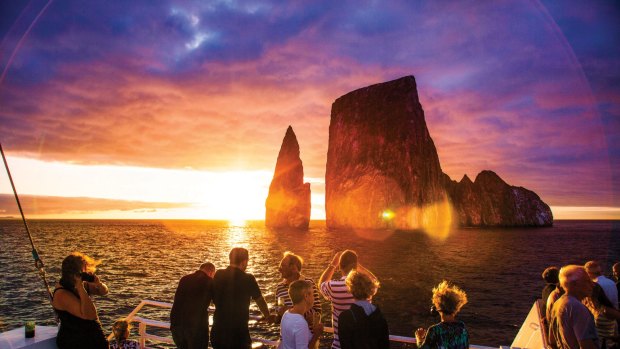
Exploring the Galapagos Islands with Lindblad Expeditions.Credit: Marco Ricca
For those hankering for truly adventurous getaways and impressive boasting rights, cocktail cruising in Monaco or Martinique just doesn't cut it. But if you think cruising confines you to the mainstream, however, then unpack your parka, bring out the binoculars and get ready for a wild ride. Some of the world's most remote destinations are only a sail away.
Now is not just the reborn golden age of cruising but also the renaissance of remote exploration by passenger ships, which variously falls under the categories of expedition, adventure or small-ship cruising. There are more ships heading to more remote locales than ever before, and even mainstream cruise companies are showing more adventurous tendencies.
FARTHEST HORIZONS
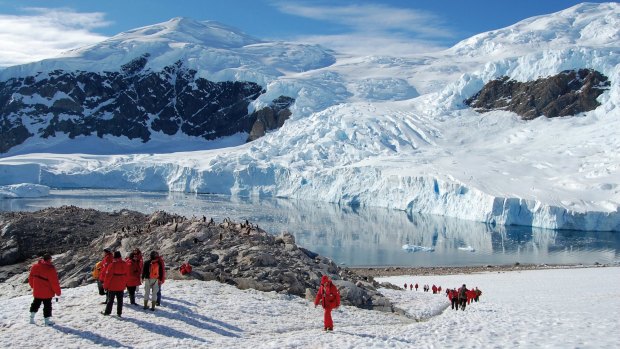
Hiking in Greenland with Ponant.Credit: Isabelle Vareille
"As Australians become more seasoned cruisers, they're definitely becoming more adventurous in seeking new horizons to explore," says Meg Hill, managing director of Cruise Express. "We've seen a marked increase in the popularity of polar cruises, and the Galapagos Islands are also trending."
Greg Carter, the co-founder of Chimu Adventures, says South America's remote Patagonia is also a hot destination for adventure cruising because it "provides stunning scenery, glaciers, pristine forests and waters, and is only a bit over 12 hours by air from Australia".
These are far from the only places opening up to cruising however, with ships sailing to East Greenland, Norway's sub-Arctic Svalbard Islands, the Russian Far East and the remote islands of Indonesia, Papua New Guinea and French Polynesia, to name but some. Africa is the only big region left that remains ripe for small-ship cruising. In the next decade, there will probably be few coastal regions in the world unavailable to those willing to cruise.
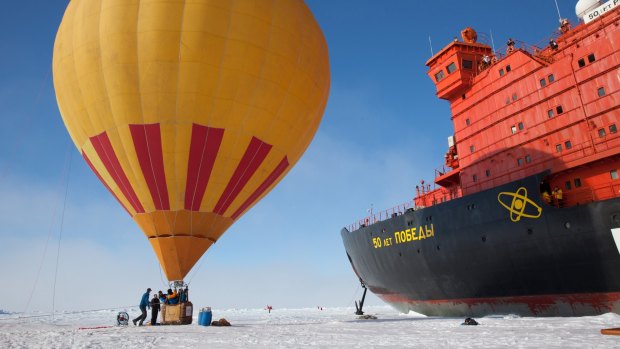
Hot air ballooning in the Arctic with Quark Expeditions.
Small ships go where big cruise liners can not, with vessels often designed to suit specific locations. Shallow draughts may allow them to hug the shoreline, and ice-strengthening capabilities – even ice-breaking capabilities for some – provide access to polar bays.
Excursions, often by Zodiac, tend to offer a more immersive experience in the environment, and are often quite active – you can kayak, scuba-dive, snorkel and even ice camp in the Arctic. Staff are often experts in their field, which may range from biology to geology, offering an educational bent for those seeking a better understanding of their destination. Unlike larger cruise ships, many expedition cruises also have flexible itineraries.
"Flexibility is a must when cruising in remote destinations," says Lisa Bolton, chief executive of Aurora Expeditions. "Being able to stop for breaching whales or an unexpected polar bear is a must, as is the ability to change schedules in case of imposing weather, ice or tides."
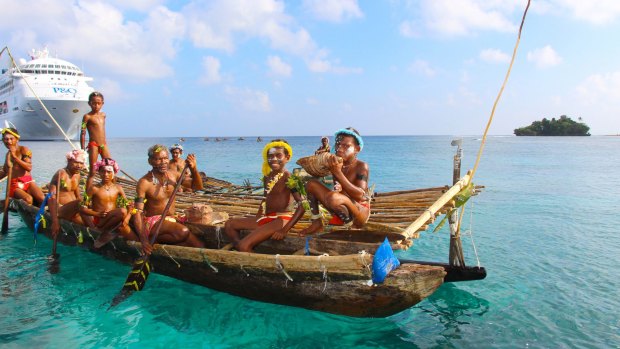
P&O Pacific Dawn on her maiden call to Kirriwina Island in PNG.
KEEP THE COMFORTS
But don't assume that such remote access comes at a sacrifice to comfort, as that isn't necessarily the case. Many small ships are high-end and provide the kind of standards, service and dining you'd expect on regular cruise lines. Silversea has menus inspired by upmarket French brand Relais & Chateaux. Quark Expeditions and North Star Cruises even provide a ship's helicopter for the ultimate in shore transfers and sightseeing flights.
Almost certainly, the next generation of ships will offer even more luxuries: even the new Aranui 5 freighter coming to French Polynesia in 2016 has upped its accommodation levels, and half the cabins will now have private balconies. That said, there's no denying that, thanks to their size, small ships inevitably proffer fewer amenities than mainstream cruise lines. The focus is squarely on the destination, not the on-board experience.
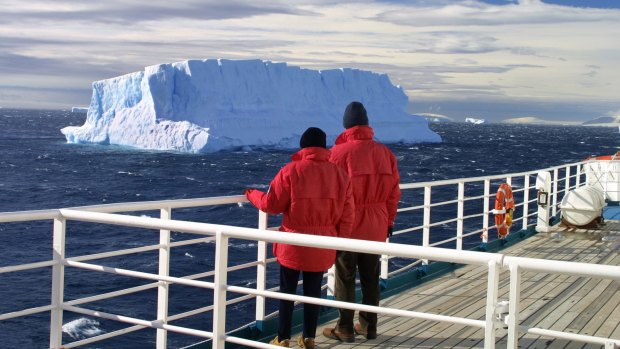
Sailing Antarctica with Chimu Adventures.
What really sets expedition ships apart from cruise liners is that they provide destinations and experiences that just wouldn't be possible to organise yourself, no matter how intrepid a traveller you may be.
"Imagine kayaking right up to the ice wall of a tidewater glacier in Antarctica," says Todd Smith, owner of AdventureSmith Explorations. "The logistics and physical demand of trying to achieve this on your own would only make it available to a handful of explorers and hard-core adventurists. Small ships make this experience possible for ordinary travellers – and afterwards you can have a nice glass of wine."
Still, even larger cruise lines have been getting more adventurous, though passenger numbers can hamper the destinations (and especially the landings) they're able to offer. P&O Cruises has become the first to offer cruise ship calls at Dili in East Timor when it sails there in 2016 as part of a Singapore-Cairns itinerary. Pacific Dawn first visited Papua New Guinea in 2013, and added Kavieng and Madang to its existing five ports this year. It now offers dedicated PNG cruise from Cairns, Brisbane and Sydney.
REMOTE CHANCE
True, small ships explore much further: one of North Star Cruises' itineraries focuses on diving the remote Louisiade Archipelago, while Aurora Expeditions visits the Trobriand Islands and Tufi fiords. Heritage Expeditions' Spirit of Enderby was the first tourist ship to visit Bipi Island, and to sail into Bougainville since its civil war.
The ships also sails to outlying islands in the Solomon Islands and Vanuatu. Looking for other remote Pacific islands? Aranui and Paul Gauguin Cruises sail to the Marquesas and Tuamotus archipelagos north-east of Tahiti.
When it comes to remoteness, there's certainly more. APT has just launched three-night and four-night cruises in the Galapagos, and in 2016 starts offering Expedition Collection Cruising for off-the-beaten-track adventures. Un-Cruise Adventures is expanding into Costa Rica and Panama on the 64-passenger Safari Voyager, which includes sloth-sighting visits to Manuel Antonio National Park and kayaking and snorkelling from the ship's customised launch platform. Nature-travel specialist Natural Habitat Adventures has announced an exclusively chartered Grizzly Ship for close encounters with the giant brown bears of Alaska.
New this year for Variety Cruises is a 10-day Madagascar & Mozambique Channel itinerary showcasing seldom-explored parts of north-west Madagascar, such as the Amber Mountain and Ankarana National Park, home to lemurs. Closer to home, Lindblad Expeditions has a new 17-day cruise out of Singapore through Borneo and the Coral Triangle, with the opportunity to snorkel Raja Ampat reefs, visit Komodo National Park beaches, and encounter orang-utans in Tanjung Puting National Park.
Even more remote is Wrangel Island in the Russian Arctic, where Heritage Expeditions offers perhaps the most exclusive shore excursion of all, available to only five passengers at once. Here you can explore one of the wildest places on the planet, where tusks of woolly mammoths are still scattered on the tundra. Speak softly and carry a big stick: there are polar bears about.
SAFETY FIRST
Finally, in respect to safety, expedition cruising has a good record. However, in 2007 MV Explorer was the first tourist ship to sink off Antarctica when it hit two icebergs. No passengers or crew were injured. At least four other ships have run aground on the Antarctic Peninsula, while Clipper Adventurer hit rocks in the Arctic's Coronation Gulf in 2010. In 2013, an expedition Zodiac was overturned by a wave in Norway, killing one passenger and injuring two others.
While remote cruising is no more dangerous than any other form of travel, there are concerns about the increasing number and size of cruise ships heading to the Poles and poorly charted waters in remote destinations. Passengers with medical issues should also consider that remote locations often have inadequate or non-existent rescue capabilities, and are a long way from medical attention.
FIVE ADVENTURES ON THE HIGH SEAS
ANTARCTICA
WHO AdventureSmith Explorations
WHAT This 12-day itinerary on the 114-passenger MV Plancius goes beyond the ordinary Antarctic cruise for those adventurous travellers who want to actively explore the white continent. With more time provided off the ship, passengers can snowshoe, kayak, hike, scuba dive and even camp out, while mountaineers can climb a glacier at Neko Harbour.
HOW Antarctic Peninsula Basecamp' itineraries, phone +1 530 583 1775, see adventuresmithexplorations.com
GALAPAGOS ISLANDS, ECUADOR
WHO Lindblad Expeditions
WHAT This 10-day cruise sails year-round on the 96-passenger Endeavour, which carries kayaks, glass-bottom boats, snorkelling gear, wet suits and Zodiac landing craft. Accompanied by a naturalist, undersea specialist and photo instructor, the cruise includes a visit to the Charles Darwin Research Station and encounters giant tortoises, blue-footed boobies, sea lions and iguanas.
HOW Galapagos Aboard National Geographic Endeavour' itineraries, phone 1300 361 012, see expeditions.com
SEPIK RIVER, PAPUA NEW GUINEA
WHO North Star Cruises
WHAT True North is the only cruise ship in Papua New Guinea to travel 160 kilometres up the Sepik River to visit remote communities at Kambaramba Lake's stilt villages. The 11-night itinerary also takes in Hermit and Ninigo atolls and the volcanoes of Bagabag Island. Passengers can try sport fishing for sailfish, black marlin and wahoo.
HOW Sepik Soiree itineraries, phone 08 91921 829, see northstarcruises.com.au
MARQUESAS AND TUAMOTU ISLANDS, PACIFIC OCEAN
WHO Aranui
WHAT The cruise-freighter Aranui 3, replaced soon by Aranui 5, takes passengers and goods from Papeete on a 14-day itinerary around the remote islands of French Polynesia. The freighter line dispenses a lifeline of food, fuel and other staples to remote ports while passengers disembark and explore on shore excursions that include hikes and 4WD tours.
HOW Aranui itineraries, phone 03 9449 3778, see aranui.com
NORTHERN SCOTLAND, UNITED KINGDOM
WHO Aurora Expeditions
WHAT As proof you can get remote in unexpected places, this 11-day voyage around northern Scotland on the 54-passenger Polar Pioneer explores Stone Age villages, World-Heritage listed St Kilda island and the Orkneys and Shetlands. Zodiac excursions take passengers through sea caves and across lochs, and allow close-up encounters with wildlife such as puffins, dolphins and seals.
HOW Wild Scotland itineraries, phone 1800 637 688 see auroraexpeditions.com.au
Get lost on these remote shore excursions
WRANGEL ISLAND, RUSSIA
WHO Heritage Expeditions
WHAT Passengers disembark for three days on this Arctic island, travelling in six-wheel tundra vehicles and overnighting in rangers' huts. The traverse climbs over the Somnitelnie Mountains into the high tundra, home to Arctic foxes and polar bears. The final day is spent on Academic Tundra, notable for musk ox, reindeer and wildflowers.
HOW Across the Top of the World itineraries, phone 1800 143 585, see heritage-expeditions.com
TORAJALAND, INDONESIA
WHO APT Small Ships
WHAT On a 17-day cruise between Darwin and Manila, this overnight excursion (with a hotel stay) on the island of Sulawesi takes passengers into a mountainous region rich in culture – perhaps best known for its elaborate funeral ceremonies – with visits to craft-rich villages and fascinating grave sites, and the opportunity to see villages planting rice in terraces.
HOW Southeast Asia Adventure itineraries, phone 1300 196 420, see aptouring.com.au.
KUNMUNYA, AUSTRALIA
WHO Aurora Expeditions
WHAT Those fit enough for a nine-hour rock-hopping bushwalk can join expedition leader Mike Cusack to retrace his 1987 Kimberley adventure, when he and wife Susan were chosen as Australian Geographic's Wilderness Couple to spend a challenging year in inhospitable Kimberley country, where they built their own wilderness home at abandoned mission site Kunmunya.
HOW Kimberley Coast itineraries, phone 1800 637 688, see auroraexpeditions.com.au
NORTH POLE
WHO Quark Expeditions
WHAT The icebreaker 50 Years of Victory brings passengers across the pack ice of the Arctic, where surely the most unusual experience in cruising (offered only by Quark) is a hot-air balloon ride just south of the North Pole – even if it is a tethered ascent, and highly dependent on weather conditions.
HOW Ultimate Arctic Adventure' itineraries, phone +1 802 490 1843, see quarkexpeditions.com
ADDO NATIONAL PARK, SOUTH AFRICA
WHO Silversea
WHAT This extended two-night shore excursion (disembarking at Durban and re-joining the ship at Port Elizabeth) sees guests stay at Gorah Elephant Camp, where they enjoy candlelit dinners overlooking a waterhole, wildlife tracking and game drives. The national park has one of the Africa's densest elephant populations and many other wildlife species.
HOW Mombassa to Cape Town itineraries, phone 1300 306 872. See silversea.com.
Frozen moments far and wide
The Arctic and Antarctic have long been considered the ultimate in remote expedition destinations, and more companies than ever before are sailing polar waters. Yet a visit to Antarctica in particular is still an exclusive experience: just 40,000 visitors a year glimpse the white continent, and only 28,000 set foot on shore.
It's easy to see the attraction. Both regions have a rich seafaring and exploration history, superb landscapes of glaciers, fiords and icebergs, and abundant wildlife, including penguins, polar bears, whales and walruses. They're also virtually impossible for travellers to visit on their own.
The range of destinations has been expanding across the Arctic region. Poseidon Expeditions, for example, visits West Greenland, Norway's Svalbard Islands and two destinations in the Russian High Arctic: Franz Josef Land and (new for summer 2016) Novaya Zemlya. Peregrine Adventures has a new 13-day cruise next year to Franz Josef Land, whose 91 islands provide opportunities to spot walruses, polar bears and beluga whales.
The Svalbard Islands have been getting much more attention because global warming has highlighted the plight of the Arctic's polar bears. In 2016, Hurtigruten will be the first company to extend its cruise season there into spring, when polar bear cubs are born.
The Canadian Arctic's fabled Northwest Passage is the last frontier. A decrease in pack ice has reopened this legendary route, and several expedition companies have journeys there. In 2012 ultra-luxe, mid-sized ship The World sailed through the passage, though with a limited number of passengers and crew on board.
Next year, Crystal Serenity sails into history when it becomes the first major cruise ship to make the passage –or at least attempt it, though weather and ice conditions will have the final say. If successful, expect more mainstream cruise ships to follow.
In the Antarctic, destinations are more tightly controlled, but companies are pushing the limits. Heritage Expeditions, for example, sails to the far south of the Ross Sea in the footsteps of the great polar explorers Scott, Shackleton, Ross and Amundsen. "In early 2016, for only the second time, we'll travel to the Bay of Whales, home to Roald Amundsen's base for the race to the South Pole. Very few expedition ships have ever sailed this far south," says general manager Dave Bowen.
Chimu Adventures has chartered a vessel for the coming two seasons that heads to Antarctica from Hobart. It allows access to Mawson's huts, base of the legendary Australian explorer, where access has been blocked by a large iceberg for the past four years. "We've seen unprecedented interest in this region – our first voyage sold out in days," says Chimu's Carter.
Polar exploration used to be a fairly rugged adventure, but more upmarket companies are offering cruises, most notably Silversea, Seabourn and Ponant. Luxe French line Ponant also has a 15-night cruise around New Zealand and Australia's rarely visited sub-Antarctic islands. Several big cruise companies – among them Celebrity Cruises, Crystal Cruises and Holland American Line – make the journey for Antarctic sightseeing, but passengers don't disembark, though some companies have shore excursions in the Falkland Islands.
Another trend is the increasing number of fly-cruises. They significantly shorten the time needed and avoid the worst of notoriously rough polar seas. Among them, Quark Expeditions is offering three new fly-cruises in the Arctic and Antarctic next year, while Active Travel has three new fly-cruise packages in Antarctica that include flight sectors between Chile and the Falkland and South Shetland islands.
Sign up for the Traveller Deals newsletter
Get exclusive travel deals delivered straight to your inbox. Sign up now.